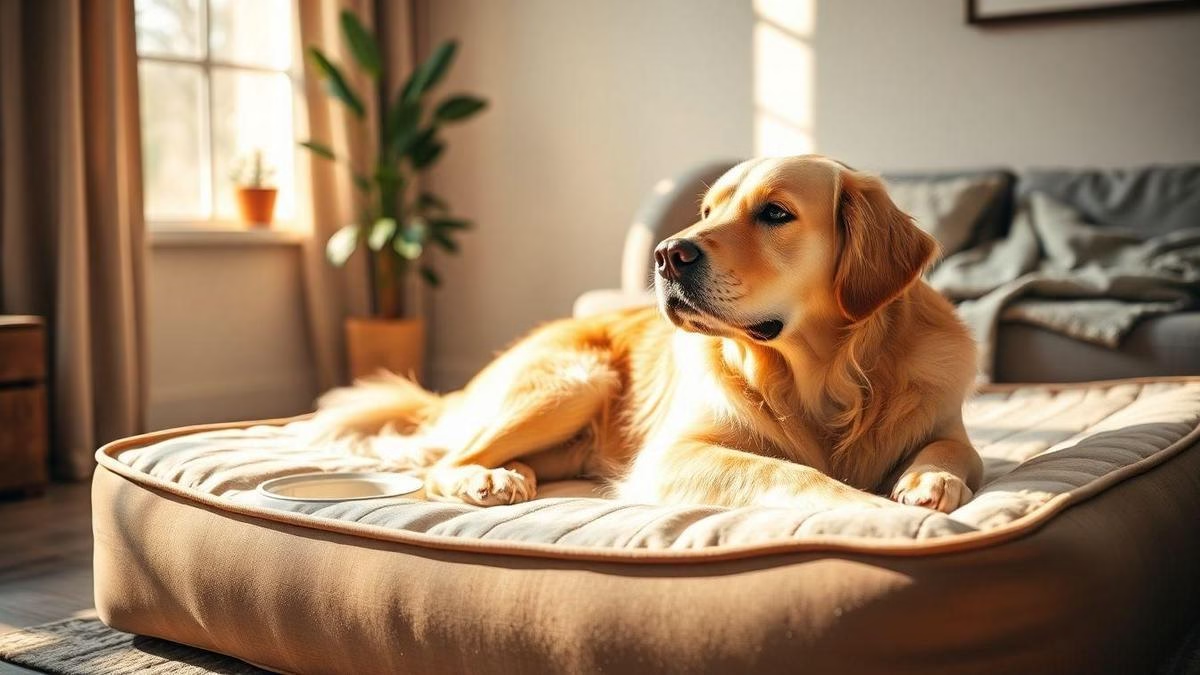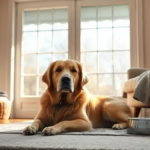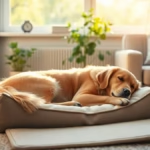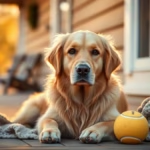Maintaining a Healthy Routine for Senior Golden Retrievers is how I keep my dog moving, comfy, and joyful. I focus on safe, low-impact walks, short gentle play, and watching pace, breath, and signs of tiredness. I use joint mobility supplements, smart meals for weight control, steady hydration, and senior-friendly food choices. Regular vet exams, simple med and appointment tracking, puzzle toys, scent games, and gentle training keep his mind sharp. Gentle grooming, ear checks, comfy bedding, and a short checklist eased my worry and deepened our bond.
Key Takeaway
- I walk my senior Golden gently every day.
- I feed my dog a senior diet and watch portions.
- I monitor weight and energy closely.
- I support joints with bedding and supplements.
- I visit the vet regularly and report small changes.
How I plan safe daily movement and maintain a healthy routine
I broke our day into small, steady blocks instead of one big session. Morning gentle walks warm joints, mid-day is a sniff-and-sit break for mental work, and evenings are calm play or slow strolls. That rhythm helped my Golden keep balance and joy without overdoing it.
I keep a simple chart on my phone to track time, distance, and how he feels after each session. Seeing patterns—when his pace drops, when he limps, and when he’s bright-eyed—made adjusting easier and gave me confidence in caring for him.
Staying consistent mattered most. Maintaining a Healthy Routine for Senior Golden Retrievers meant I watched weight, food timing, and sleep along with movement. Some days were more mental puzzles than walking; other days were slow, scenic walks. That give-and-take kept him steady and happy.
| Time of day | Activity | Duration | Intensity |
|---|---|---|---|
| Morning | Gentle walk on soft ground | 10–20 min | Low |
| Mid-day | Sniffing short training/mental game | 5–15 min | Low |
| Evening | Slow stroll or calm play | 10–25 min | Low–Moderate |
Low-impact walks and short play sessions
I pick soft surfaces—grass, dirt paths, beach sand when possible. Hard concrete can jolt aging joints. Walks are slow with frequent sniffing stops. I toss a soft toy a few feet sometimes, but never make him sprint. Short bursts of play keep his mood bright without stressing his body. For more structured ideas on safe routines and movements, I referred to a guide on safe and beneficial exercises for senior Golden Retrievers.
For indoor days I use quiet games: scent trails with small treats, gentle tug on a soft rope, or short hide-and-seek rounds. These keep his brain sharp and burn energy without running. I always end the game before he looks tired — scent-based activities are especially helpful and I often combine them with tips from a page about mental enrichment activities for senior Goldens.
Watching pace, breathing, and signs of fatigue
I learned to read subtle signals: a slower tail wag, shorter strides, or a tucked back. If breaths turn fast or shallow after a short walk, I stop and give water. Feeling for heat around joints and watching for limping tells me when to rest. These signs are whispers; listening early prevents bigger problems. For help identifying pain and early warning signs, I keep a reference handy on signs of pain in senior Golden Retrievers.
When I notice any of these signs, I act fast and gentle: rest, water, and a shorter next session. If something is off for more than a day, I call my vet.
Quick checks:
- Check breathing: fast or shallow → stop and rest.
- Look at gait: limping or short steps → end session and inspect paws.
- Feel joints: warm or swollen → cool compress and limit movement.
- Watch behavior: unusually quiet or withdrawn → skip exercise and monitor.
- Call vet if signs persist beyond 24 hours or worsen.
Using joint mobility supplements
After talking with my vet I started supplements and saw small gains in comfort. We chose a formula with omega-3, glucosamine, and chondroitin, given with his morning meal. In a few weeks his step grew lighter. I track energy, stiffness, and appetite, and adjust only on vet advice. Supplements felt like giving him a little extra cushion for each step. For broader ideas on managing mobility and practical solutions, I looked at advice on mobility issues and practical solutions.
How I manage meals and weight with senior Golden retriever diet and nutrition
I weigh him every two weeks and write the number down. If the scale drifts up, I cut treats and trim meal size slowly. If he loses weight, I add a few tasty calories and call the vet. I check body shape with my hands—ribs should be easy to feel, not hidden under a thick layer.
I built a steady daily plan and call it maintaining a routine that works. Maintaining a Healthy Routine for Senior Golden Retrievers became my goal after he slowed down at ten. I feed at set times, use the same measuring cup, and limit treats to one or two a day. This rhythm keeps digestion calm and makes it easier to spot small changes fast.
Morning is dry kibble measured by cup; evening is a small scoop of wet food or warmed broth to tempt appetite. On vet-recommended days I add supplements. I keep notes about appetite, stool, energy, and fur—this log tells me more than any single meal. For a complete look at feeding seniors I often consult a complete guide to nutrition for Golden Retrievers over 7.
Portion control and weight management tips
I keep portion control simple: measure, record, adjust. Start with the feeding guide on the bag, then lower by 10–15% if your dog sits more than he walks. Small changes over weeks work better than drastic cuts.
I also use activity to balance calories: short walks, gentle play, and inside sniff-and-seek games burn energy without stressing joints. When weight needs to come off, reduce treats first, then food. Swap high-calorie snacks for praise, a rub, or a lick of safe broth. For practical plans and step-by-step weight strategies, see tips on maintaining ideal weight in senior Goldens.
- Weigh your dog and set a target weight.
- Measure daily food with the same cup.
- Reduce calories slowly (about 10% every 2–3 weeks if needed).
- Swap treats for low-calorie options or praise.
- Increase light activity and recheck weight weekly.
Hydration and supplement recommendations
Water is everything. My Golden sometimes forgets to drink, so I keep two bowls in different rooms and refresh them twice a day. On hot days or after a walk I add a splash of low-sodium broth. If he drinks less, I offer wet food because it adds water gently.
For joints and coat, glucosamine and fish oil helped stiffness; a probiotic smoothed stomachs when food changed. I watch for changes for two weeks after adding a supplement. If he reacts badly, I stop it. Always check with your vet first. For ideas to make meals more appealing and encourage eating, I reference notes on creating appetizing meal experiences for senior Goldens and ways to stimulate appetite.
Choosing senior-friendly kibble and wet food
Pick kibble with clear protein sources, moderate calories, added fiber, and omega-3s. Smaller kibble helps older teeth. For wet food, favor single-protein options and gentle recipes with pumpkin or rice if he has tummy trouble. Test small bags to be sure he likes it and it agrees with him.
| Nutrient | Why it matters | Food sources |
|---|---|---|
| High-quality protein | Protects muscle mass | chicken, turkey, fish |
| Omega-3 fatty acids | Reduces joint pain, supports coat | salmon, fish oil |
| Fiber | Aids digestion and weight control | pumpkin, beet pulp |
How I schedule vet visits and tests
I set vet visits every six months and more often if something changes. Regular visits let me catch problems early and keep Buddy comfortable. Maintaining a Healthy Routine for Senior Golden Retrievers became a daily promise, not a chore. For recommended screening schedules and preventative care, I follow guidance from essential veterinary care for Golden Retrievers in their golden years.
I pick appointment times when he’s freshest so labs are easier and stress is lower. I book the next appointment before we leave the clinic and keep a file with past results and notes to scan for trends—weight, appetite, limps, or coat changes.
Why exams every six months
Older Goldens can change fast. Six months gives a steady check on organs, weight, and joints. Problems like kidney disease or early arthritis show up slowly; twice-yearly checks help catch trouble early and allow timely adjustments to meds and diet.
Routine screenings I ask for
I ask for a CBC and chemistry panel, urinalysis, and a joint/mobility exam. These tests are a health snapshot and help spot organ stress, infection, or early joint disease. If needed, we add X-rays or orthopedic consults.
What I bring to appointments: recent records, a list of behavior changes, medication list, and a short video of any odd behavior.
| Test | Why it matters | Typical frequency |
|---|---|---|
| Blood work (CBC chemistry) | Shows organ function, anemia, infection | Every 6 months |
| Urinalysis | Detects kidney issues, infection, diabetes | Every 6 months |
| Joint check / mobility exam | Finds arthritis, pain points, limping causes | Every 6 months or as needed |
| Dental check | Prevents gum disease that affects organs | Annually or as recommended |
How I track medications and reminders
I use my phone calendar with alarms and a small pill box labeled by day. I keep a short sheet with drug name, dose, and why he takes it. Each refill gets recorded with the next appointment date. A photo of the pill bottle in my notes helps avoid mistakes.
How I keep his mind active with mental stimulation
Age slowed his legs but not his curiosity. I make mental games part of his daily life so he stays interested, calm, and connected. Small wins—finding a hidden kibble or solving a gentle puzzle—light him up.
I mix easy challenges with familiar routines. Some days we do scent walks; other days we spend five minutes on a new cue. That steady rhythm helps with Maintaining a Healthy Routine for Senior Golden Retrievers and keeps his mind engaged.
If he seems tired I switch to a soothing scent game or a soft massage; if bright, I bring out a simple puzzle. My goal is to keep his world interesting without pushing him. For additional activity ideas, I rely on resources about keeping a senior Golden’s mind active and specific mental enrichment activities.
Puzzle toys, scent games, and gentle training
Puzzle toys give him a job that doesn’t wear him out. I use low-difficulty puzzles so he can succeed fast—success fuels confidence. Scent games are magic for retrievers: hide treats in towels or cups and let him search. Gentle training keeps memory sharp: five-minute sessions teaching one cue or reinforcing wait keep us bonded.
- Kibble-dispensing ball — gentle push, food reward
- Snuffle mat — hides many small treats, encourages sniffing
- Soft hide-and-seek plush — easy grip, soft fabric
- Muffin tin with balls — simple problem solving with snacks
- Scent trails around the yard — low-effort tracking
| Activity | Benefit |
|---|---|
| Snuffle mat / scent games | Low-impact sniffing that tires the brain, not the body |
| Soft puzzle toys | Problem solving and confidence from small successes |
| Short training bites | Keeps memory sharp and strengthens our bond |
| Scent walks | Stimulates curiosity while being gentle on joints |
Social time and short learning sessions
Short, calm visits from a friend’s dog or a quiet park meet-and-greet brightened him. He doesn’t need wild play; he needs connection. Short learning sessions—five minutes, two or three times daily—keep him engaged without fatigue. For ideas on strengthening relationship and shared activities, I read about building stronger bonds with your senior Golden.
Rotating activities to match energy and cognition
I rotate activities: soft puzzles in the morning, a scent walk midday, social time later. If he’s foggy one day, I go easy. If he’s bright, I add a new cue. Changing things keeps him curious and lets me match his energy without straining him.
How I care for coat, skin, and rest — grooming and skin care
Grooming is a gentle ritual. I brush every other day to remove loose hair and spot skin changes. Brushing is quiet time—he relaxes, and I can feel tender spots. Maintaining a Healthy Routine for Senior Golden Retrievers keeps small problems from turning into big ones. For specific grooming and skin-care steps, I consult a guide on coat and skin care for senior Goldens.
I check ears, pads, and coat for sores or lumps during grooming. Baths are less frequent—just enough to remove dirt and soothe itchy patches—with a mild, pH-balanced senior shampoo. I date and photo any odd lump and call the vet if it stays or worsens.
Sleep and rest are part of the plan. After grooming I make sure he has a warm place to nap. I adjust room temperature and use soft evening lighting; these small changes help him sleep more deeply. For tips on choosing the best bed, I used a checklist from how to choose the perfect bed for a senior Golden Retriever.
| Task | Frequency | Quick note |
|---|---|---|
| Brushing | Every 2 days | Short strokes, watch for lumps or hot spots |
| Ear check | Weekly | Clean only if wax buildup or smell |
| Bath | Every 6–8 weeks | Use senior-formula shampoo |
| Nail trim | Every 3–6 weeks | Shorter nails help with joint comfort |
| Skin exam | During every grooming | Note any lumps or sores, date them |
Brushing, ear care, and checking for lumps
I brush with a soft slicker then a wide-tooth comb to reach under the coat. If he flinches, I stop and try again gently. For ears I look for odor, redness, or extra wax and clean only the outer ear with a vet-approved solution. If a lump grows, bleeds, or causes pain, I call the vet. For step-by-step hygiene and paw tips, I refer to hygiene care for senior Goldens and nail and paw pad care.
Tips:
- Start calm with gentle praise.
- Run hands over the whole body, then part the coat.
- Inspect ears, pads, and folds carefully.
- Note any changes with date and photo; contact vet if it worsens.
Creating a comfy bed and seasonal care
I chose a low-entry memory foam bed so he can climb in without jumping. I place it near my chair so he sleeps close. A washable blanket that smells like me lowers anxiety. In cold months I use a low-heat pad for short periods; in hot months I avoid midday pavement and check pads for burns.
Seasonal tips:
- Winter: moisturize paw pads, wipe feet after walks to remove salt.
- Summer: avoid hot pavement; walk early or late.
- Dry air: use a humidifier and vet-approved moisturizers for scaly areas.
Lessons from my daily checklist to help others
I made a simple checklist the day my Golden started slowing down and stuck it to the fridge. That habit changed our days. It kept me honest and gave him predictability. Maintaining a Healthy Routine for Senior Golden Retrievers became less like a chore and more like a promise. For a practical daily checklist and comfort routine ideas, I drew on a daily comfort routines resource.
The checklist balances short walks, joint care, and brain games. It saved me from panicking over food or naps—small records made problems easy to spot and vet visits calmer.
Simple routines that improved mobility and mood
Short, regular walks replaced long sessions; I let him set the pace. Those shorter walks, two or three times a day, loosened his joints without tiring him out. I mixed in slow sniffing stops and added light massage and stretching after walks. For massage techniques I sometimes refer to basic therapeutic massage techniques.
- Morning: gentle 15–20 min walk light stretching
- Midday: indoor scent game or short play (5–10 min)
- Evening: calm walk and 2–3 min massage before bed
Practical weight management that worked for us
When he crept up a few kilos, I stopped free feeding and used measured meals. I swapped treats for green beans and kibble rewards. Regular weigh-ins at home and vet visits helped me adjust portions and activity. Slow, steady change won the day.
| Situation | Action I took |
|---|---|
| Slight weight gain | Measure meals; swap treats for veggies; add two short walks daily |
| Stable/ideal weight | Maintain measured portions; weekly weigh-ins; gentle play |
| Weight loss/low appetite | Vet check; calorie-dense senior food; smaller, more frequent meals |
Small lifestyle changes that enriched our bond
I built a ramp to the couch so he could join me without jumping, kept a warm bed near the heater, and turned grooming into a spa hour. Short training games that used his nose more than his legs made time together richer. For additional ideas about adapting the home for aging pets, I reviewed how to adapt your home for a senior Golden.
Conclusion
A steady, gentle routine is the backbone of good senior care. Small daily choices—short walks, careful portion control, steady hydration, and consistent grooming—stack up and create measurable change. I listen for soft signals—shorter strides, heavier breathing—and act fast. That listening, more than any product, keeps him comfortable.
Keeping a simple checklist, tracking weight and moods, and partnering with my vet gave me confidence when things felt uncertain. Supplements, ramps, soft beds, and scent games weren’t magic fixes, but they were the right tools at the right time. I adjusted slowly, praised often, and chose quality over quick fixes.
Most of all, this routine deepened our bond. Those quiet grooming moments, easy games, and slow strolls became our language. If you’re starting out, focus on small, repeatable habits to begin Maintaining a Healthy Routine for Senior Golden Retrievers—one steady step at a time. For more tips and stories I also visit real stories of senior Goldens and other resources on TopCuriosities.
For more tips, visit https://topcuriosities.com.

Rafael Souza is a digital marketing strategist and lifelong dog enthusiast. Passionate about Golden Retrievers, he shares practical, research-based tips to help owners provide healthier and happier lives for their furry companions.





